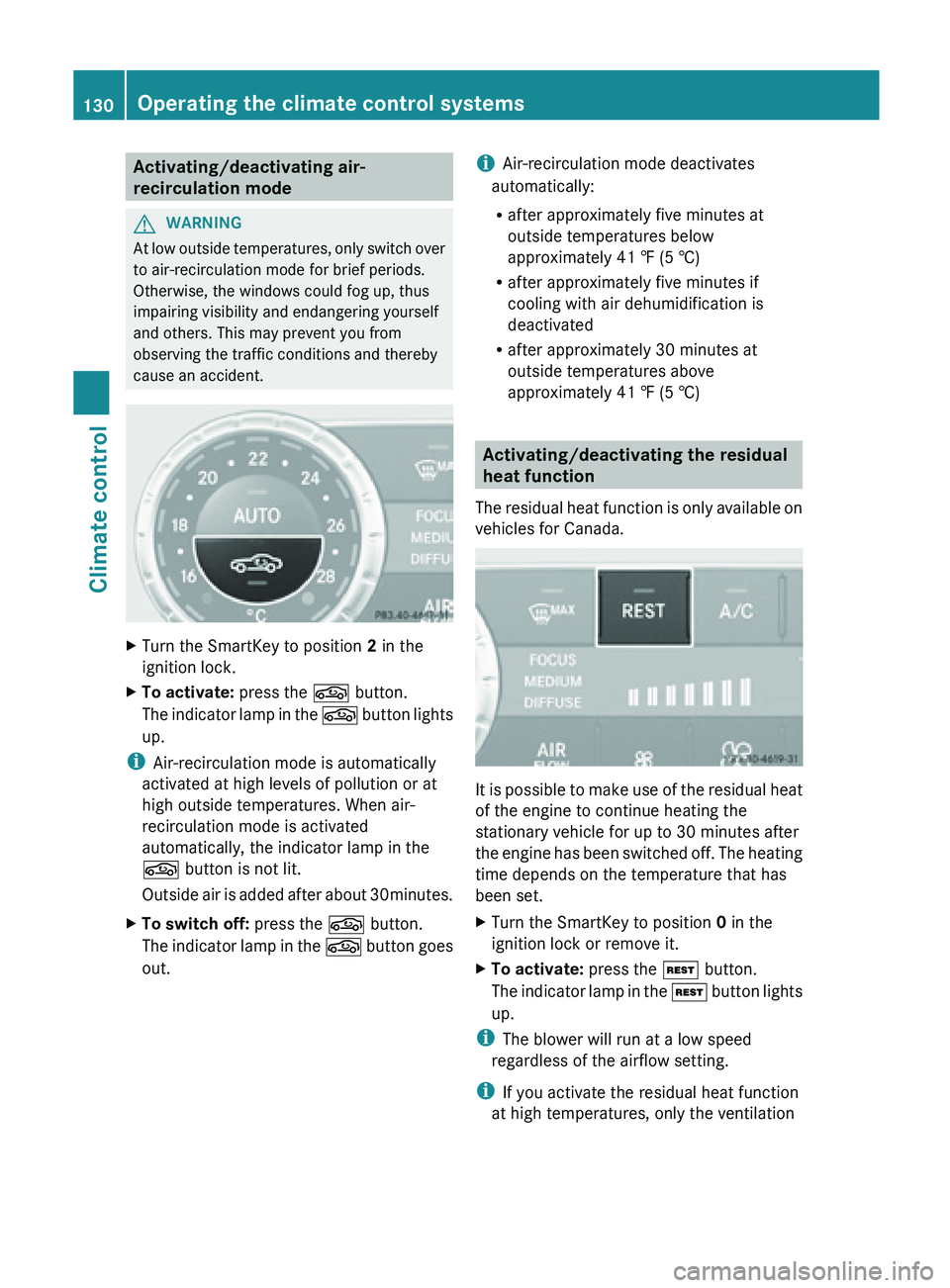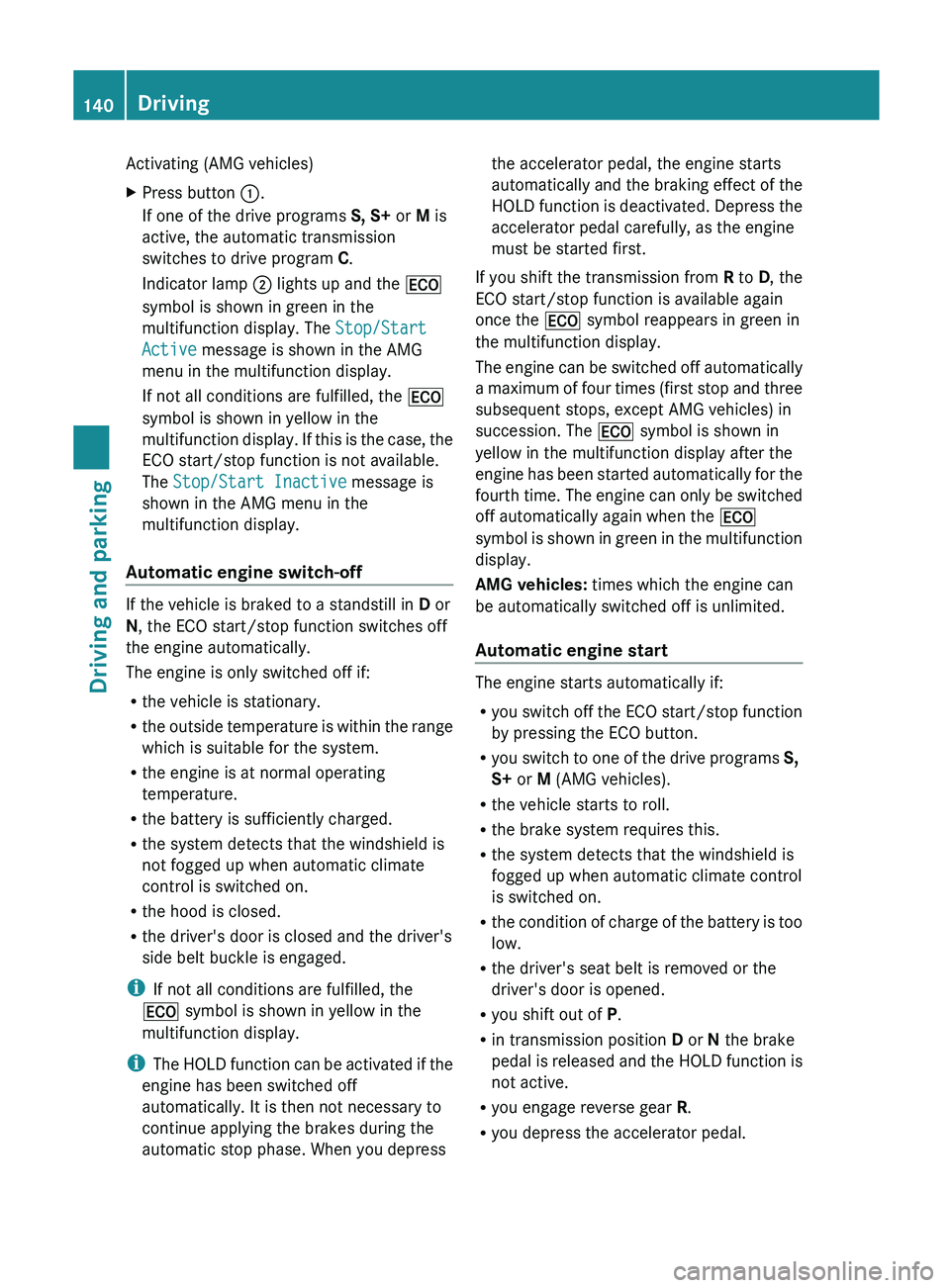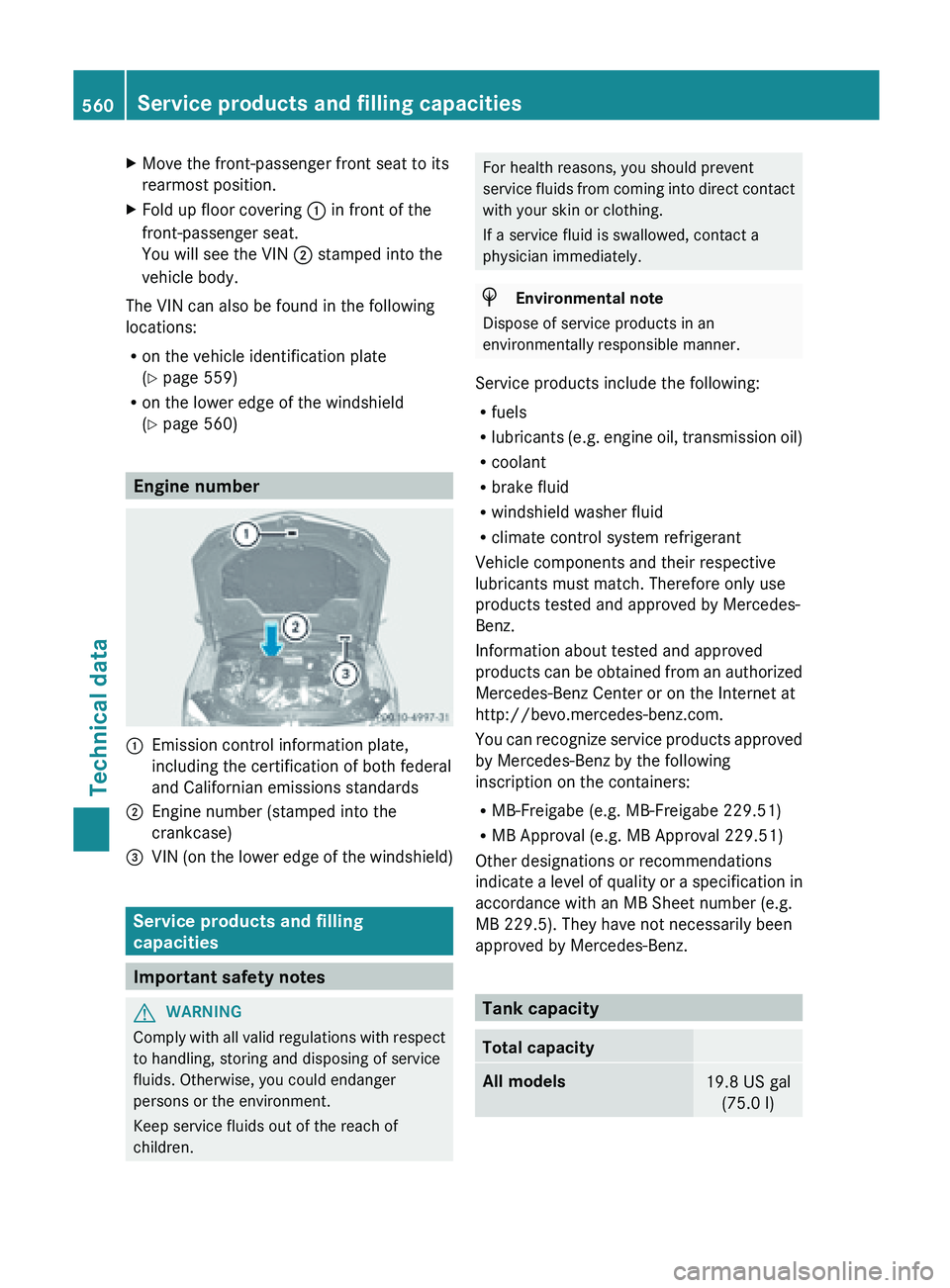2013 MERCEDES-BENZ SL-CLASS ROADSTER climate control
[x] Cancel search: climate controlPage 132 of 572

Activating/deactivating air-
recirculation mode
G
WARNING
At low outside temperatures, only switch over
to air-recirculation mode for brief periods.
Otherwise, the windows could fog up, thus
impairing visibility and endangering yourself
and others. This may prevent you from
observing the traffic conditions and thereby
cause an accident. X
Turn the SmartKey to position 2 in the
ignition lock.
X To activate: press the g button.
The indicator
lamp in the g button lights
up.
i Air-recirculation mode is automatically
activated at high levels of pollution or at
high outside temperatures. When air-
recirculation mode is activated
automatically, the indicator lamp in the
g button is not lit.
Outside air
is added after about 30minutes.
X To switch off: press the g button.
The indicator
lamp in the g button goes
out. i
Air-recirculation mode deactivates
automatically:
R after approximately five minutes at
outside temperatures below
approximately 41 ‡ (5 †)
R after approximately five minutes if
cooling with air dehumidification is
deactivated
R after approximately
30 minutes at
outside temperatures above
approximately 41 ‡ (5 †) Activating/deactivating the residual
heat function
The residual
heat function is only available on
vehicles for Canada. It
is possible to make use of the residual heat
of the engine to continue heating the
stationary vehicle for up to 30 minutes after
the engine
has been switched off. The heating
time depends on the temperature that has
been set.
X Turn the SmartKey to position 0 in the
ignition lock or remove it.
X To activate: press the Ì button.
The indicator
lamp in the Ì button lights
up.
i The blower will run at a low speed
regardless of the airflow setting.
i If you activate the residual heat function
at high temperatures, only the ventilation 130
Operating the climate control systems
Climate control
Page 133 of 572

will be activated. The blower runs at
medium speed.
X To switch off: press the Ì button.
The indicator
lamp in the Ì button goes
out.
Residual heat is deactivated automatically:
R after approximately 30 minutes
R when the ignition is switched on
R if the battery voltage drops
R if the coolant temperature is too low Setting the air vents
Important safety notes
G
WARNING
Very hot or very cold air can flow from the air
vents. This could cause burns or frostbite to
bare skin in the immediate vicinity of the
vents. Keep bare skin away from these air
vents. If
necessary, direct the airflow away to
a different area of the vehicle interior.
In order to ensure the direct flow of fresh air
through the air vents into the vehicle interior,
please observe the following notes:
R keep the air inlet grille on the hood and in
the engine compartment on the front-
passenger side free of blockages, such as
ice, snow or leaves.
R never cover the air vents or air intake grilles
in the vehicle interior.
i You can move the adjusters for the air
vents vertically or horizontally to set the
direction of the airflow.
i For optimal climate control in the vehicle,
open the air vents completely and set the
adjusters to the central position. Setting the center air vents
X
To open a center air vent: turn the
adjuster in one of center air vents :
counterclockwise.
X To close a center air vent: turn the
adjuster in one of center air vents :
clockwise until it engages. Setting the side air vents
:
Side window defroster vent
; Side air vent
X To open a side air vent: turn the adjuster
in side air vent ; counterclockwise.
X To close a side air vent: turn
the adjuster
in side air vent ; clockwise until it
engages. Setting the glove box air vent
! Close the air vent when heating the
vehicle. Setting the air vents
131
Climate control Z
Page 134 of 572

At high outside temperatures, open the air
vent and activate the "cooling with air
dehumidification" function. Otherwise,
temperature-sensitive items stored in the
glove box could be damaged.
:
Air vent thumbwheel
; Air vent
When automatic climate control is activated,
the glove box can be ventilated, for instance
to cool its contents. The level of airflow
depends on the airflow and air distribution
settings.
X To open/close: turn thumbwheel :
clockwise or counterclockwise. AIRSCARF, setting the vents
G
WARNING
When operating the climate control, the air
that enters the passenger compartment
through the air vents can be very hot or very
cold (depending
on the set temperature). This
could cause burns or frostbite to unprotected
skin in the immediate area of the air vents.
Always keep sufficient distance between
unprotected parts of the body and the air
vents. If necessary, use the air distribution
adjustment to direct the air to air vents in the
vehicle interior that are not in the immediate
area of unprotected skin. You can adjust the blower output of
AIRSCARF vents
: using the AIRSCARF
button ( Y page 101).132
Setting the air vents
Climate control
Page 142 of 572

Activating (AMG vehicles)
X
Press button :.
If one of the drive programs S, S+ or M is
active, the automatic transmission
switches to drive program C.
Indicator lamp ; lights up and the ¤
symbol is shown in green in the
multifunction display. The Stop/Start
Active message is shown in the AMG
menu in the multifunction display.
If not all conditions are fulfilled, the ¤
symbol is shown in yellow in the
multifunction display.
If this is the case, the
ECO start/stop function is not available.
The Stop/Start Inactive message is
shown in the AMG menu in the
multifunction display.
Automatic engine switch-off If the vehicle is braked to a standstill in
D or
N, the ECO start/stop function switches off
the engine automatically.
The engine is only switched off if:
R the vehicle is stationary.
R the outside
temperature is within the range
which is suitable for the system.
R the engine is at normal operating
temperature.
R the battery is sufficiently charged.
R the system detects that the windshield is
not fogged up when automatic climate
control is switched on.
R the hood is closed.
R the driver's door is closed and the driver's
side belt buckle is engaged.
i If not all conditions are fulfilled, the
¤ symbol is shown in yellow in the
multifunction display.
i The HOLD function can be activated if the
engine has been switched off
automatically. It is then not necessary to
continue applying the brakes during the
automatic stop phase. When you depress the accelerator pedal, the engine starts
automatically
and
the braking effect of the
HOLD function is deactivated. Depress the
accelerator pedal carefully, as the engine
must be started first.
If you shift the transmission from R to D, the
ECO start/stop function is available again
once the ¤ symbol reappears in green in
the multifunction display.
The engine can be switched off automatically
a maximum of four times (first stop and three
subsequent stops, except AMG vehicles) in
succession. The ¤ symbol is shown in
yellow in the multifunction display after the
engine has been started automatically for the
fourth time. The engine can only be switched
off automatically again when the ¤
symbol is shown in green in the multifunction
display.
AMG vehicles: times which the engine can
be automatically switched off is unlimited.
Automatic engine start The engine starts automatically if:
R
you switch
off the ECO start/stop function
by pressing the ECO button.
R you switch to one of the drive programs S,
S+ or M (AMG vehicles).
R the vehicle starts to roll.
R the brake system requires this.
R the system detects that the windshield is
fogged up when automatic climate control
is switched on.
R the condition of charge of the battery is too
low.
R the driver's seat belt is removed or the
driver's door is opened.
R you shift out of P.
R in transmission position D or N the brake
pedal is released and the HOLD function is
not active.
R you engage reverse gear R.
R you depress the accelerator pedal.140
DrivingDriving and parking
Page 278 of 572

Climate control status display
The climate status display in the COMAND display
(example)
If you change the settings of the climate
control system, the climate status display
appears for three seconds at the bottom of
the screen in the COMAND display. You will
see
the
current settings of the various climate
control functions.
Overview of climate control systems
(Y page 122).
The climate status display appears when:
X You turn one of the two temperature
controls and
set the temperature to the left
or right.
or
X You press one of the following buttons:
K Increases air flow
I Decreases air flow
¿ Switches climate control on/off
á Switches the ZONE function on/off
à Controls the air conditioning
automatically
ñ Sets the climate control style in
automatic mode (FOCUS/MEDIUM/
DIFFUSE)
_ Sets the air distribution
¬ Turns on the defrost function
Ù Turns on maximum cooling Example settings for the defrost function (top) and
for the climate mode in automatic mode
X
To hide the display: turn or press the
COMAND controller.
or
X Press one of the buttons on COMAND.
Displaying the image from the rear view
camera G
WARNING
The rear view camera is only an aid and may
show a distorted view of obstacles, show
them incorrectly or not at all.
Further information on the rear view camera
(Y page 190).
The image from the rear view camera is
shown in the COMAND display when reverse
gear is engaged if:
R your vehicle is equipped with a rear view
camera.
R COMAND is switched on
R the Activation by R gear function is
activated.
If the function is activated, the COMAND
display will automatically switch back to the
previously selected display as soon as you
shift out of reverse gear.
i Further information on the rear view
camera ( Y page 190).
X Press the W function button.
The system menu appears.
X Select Settings by turning cVd the
COMAND controller and press W to
confirm. 276
At a glance
COMAND
Page 542 of 572

All about wheels and tires
Uniform Tire Quality Grading
Standards
Overview of Tire Quality Grading
Standards Uniform Tire Quality Grading Standards are
U.S. government specifications. Their
purpose is to provide drivers with uniform
reliable
information
on tire performance data.
Tire manufacturers have to grade tires using
three performance factors: treadwear
grade :, traction grade ; and temperature
grade =. These regulations do not apply to
Canada. Nevertheless, all tires sold in North
America are provided with the corresponding
quality grading markings on the sidewall of
the tire.
Where applicable, the tire grading
information can be found on the tire sidewall
between the tread shoulder and maximum
tire width.
Example:
R Treadwear grade: 200
R Traction grade: AA
R Temperature grade: A
All passenger car tires must conform to the
statutory safety requirements in addition to
these grades.
i The actual values for tires are vehicle-
specific and may deviate from the values in
the illustration. Treadwear The treadwear grade is a comparative rating
based
on
the wear rate of the tire when tested
under controlled conditions on a specified
U.S. government course. For example, a tire
graded 150 would wear one and one-half
times as well on the government course as a
tire graded 100.
The relative performance of tires depends
upon the actual conditions of their use,
however, and may depart significantly from
the norm, due to variations in driving habits,
service practices and differences in road
characteristics and climate conditions.
Traction G
WARNING
The traction grade assigned to this tire is
based on straight-ahead braking traction
tests, and does not include acceleration,
cornering, hydroplaning, or peak traction
characteristics.
! Avoid wheelspin.
This can lead to damage
to the drive train.
The traction grades, from highest to lowest,
are AA, A, B, and C. Those grades represent
the tire's ability to stop on a wet surface as
measured under controlled conditions on
specified government test surfaces of asphalt
and concrete. A tire marked C may have poor
traction performance.
The safe speed on a wet, snow covered or icy
road is always lower than on dry road
surfaces.
You should pay special attention to road
conditions when temperatures are around
freezing point.
Mercedes-Benz recommends a minimum
tread depth of ã in (4 mm) on all four winter
tires. Observe the legally required minimum
tire tread depth (Y page 527). Winter tires can
reduce the braking distance on snow-covered
surfaces in comparison with summer tires.
The braking distance is still much further than 540
All about wheels and tires
Wheels and tires
Page 562 of 572

X
Move the front-passenger front seat to its
rearmost position.
X Fold up floor covering : in front of the
front-passenger seat.
You will see the VIN ; stamped into the
vehicle body.
The VIN can also be found in the following
locations:
R on the vehicle identification plate
(Y page 559)
R on the lower edge of the windshield
(Y page 560) Engine number
:
Emission control information plate,
including the certification of both federal
and Californian emissions standards
; Engine number (stamped into the
crankcase)
= VIN (on the lower edge of the windshield) Service products and filling
capacities
Important safety notes
G
WARNING
Comply with all valid regulations with respect
to handling, storing and disposing of service
fluids. Otherwise, you could endanger
persons or the environment.
Keep service fluids out of the reach of
children. For health reasons, you should prevent
service
fluids
from coming into direct contact
with your skin or clothing.
If a service fluid is swallowed, contact a
physician immediately. H
Environmental note
Dispose of service products in an
environmentally responsible manner.
Service products include the following:
R fuels
R lubricants (e.g.
engine oil, transmission oil)
R coolant
R brake fluid
R windshield washer fluid
R climate control system refrigerant
Vehicle components and their respective
lubricants must match. Therefore only use
products tested and approved by Mercedes-
Benz.
Information about tested and approved
products can be obtained from an authorized
Mercedes-Benz Center or on the Internet at
http://bevo.mercedes-benz.com.
You can recognize service products approved
by Mercedes-Benz by the following
inscription on the containers:
R MB-Freigabe (e.g. MB-Freigabe 229.51)
R MB Approval (e.g. MB Approval 229.51)
Other designations or recommendations
indicate a level of quality or a specification in
accordance with an MB Sheet number (e.g.
MB 229.5). They have not necessarily been
approved by Mercedes-Benz. Tank capacity
Total capacity
All models
19.8 US gal
(75.0 l)560
Service products and filling capacities
Technical data